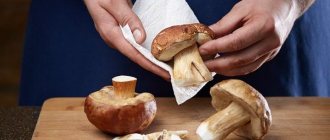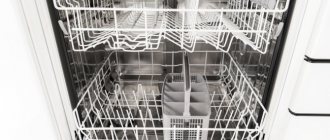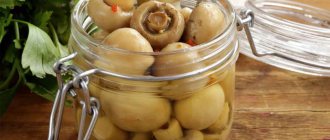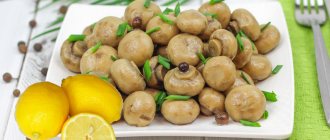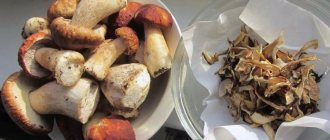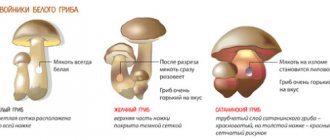Mushrooms
0
1329
Article rating
Kira Stoletova
The first priority after harvesting is processing the mushrooms. There is no need to delay the process, because the product quickly deteriorates. If it is not possible to process the crop immediately after arriving from the forest, you are allowed to postpone work for only a few hours. To properly prepare mushrooms for consumption, you need to learn certain rules.
Mushroom processing
Mechanical restoration
First, the harvested crop is carefully inspected. If there are unfamiliar specimens that raise doubts, it is better to throw them away. Fruiting bodies are not consumed if they:
- wormy;
- rotten;
- with mold;
- with mucus;
- damaged.
Sorting
Mechanical processing is carried out regardless of whether the mushrooms will be used immediately, fresh or intended for canning. They are sorted by type and size because they are prepared differently and also differ in taste. Only small fruiting bodies are suitable for harvesting. Mushrooms are divided into those that are fried immediately and those that require preliminary boiling.
Cleaning
It is worth getting rid of debris and small insects brought from the forest along with the harvest. To do this, use a soft brush or rag. You can process the fruiting bodies with a knife. If the product is dried, fried, baked, it is not washed.
Irina Selyutina (Biologist):
To easily remove the film from the caps of boletus and russula, you can hold them in boiling water for 1-2 minutes, then discard them in a colander and rinse with cold water. You can simply grab it along the edge with a knife and remove it by moving your hand from the edges of the cap to the center. Clean until the surface turns white.
Then we separate the stem and make sure that there are no fungal worm passages in it or in the cap. If the lesion is large, throw away the mushroom. If the lesion looks small, cut the stem and cap into separate pieces and look again. We leave only “clean” pieces. We do not remove the skin from the cap of boletus, boletus and moss mushrooms, but immediately clean the fruiting body from forest debris and again check for worms and cut into pieces. The legs can be placed on wheels 1-1.5 cm thick, the caps can be placed on equal-sized segments - halves, quarters.
Areas of fruiting bodies damaged by pests are carefully cut out with a knife. All darkening and damage are removed. For old tubular mushrooms, remove the inner (lower) part of the cap - the tubular hymenophore.
Washing
Mushrooms should be treated with cold water. Immediately after this, wait until the excess liquid drains from the fruiting bodies. Longer rinsing is required for species that have an uneven surface. These include morels, lines, etc. Sand sticks to the folded surface of the caps of these specimens, which needs to be washed off. If the fruiting bodies are intended for drying or frying, such manipulations are not performed.
Soaking
Conditionally edible species require enhanced taste.
This is achieved by immersing the mushrooms in salted water for several hours or a day. The liquid is periodically changed to fresh. For this, a low and wide vessel is selected; basins or bowls are best suited for these purposes. Afterwards the bitterness will go away. Dry fruit bodies are also soaked. This helps restore moisture. Experienced mushroom pickers recommend cutting the milk mushrooms into slices before soaking - this will better remove the bitterness from the fruiting bodies. By the way. It is not recommended to use aluminum or stainless steel utensils for soaking milk mushrooms, in order to avoid the occurrence of chemical reactions between the surface of the container and the released juice (even if mixed with water).
Slicing
Large specimens are divided into parts. To ensure that the dish has a good taste, the leg is cut into circles across the grain. The hats are divided into equal parts. For canning, small fruiting bodies are used entirely.
How to process conditionally edible mushrooms after collection
How to distinguish conditionally edible mushrooms
Is there a difference between poisonous and inedible mushrooms? Isn't this the same thing? No. The fact is that inedible mushrooms are not eaten in most cases, not because they can cause great harm to the body, but because:
- unpleasant taste or smell;
- small fruiting bodies;
- pulp hardness;
- growths on the fruiting body (scales, thorns, etc.);
- specificity of the place of growth;
- rarities.
In addition to the listed parameters, the inedibility of mushrooms can also be expressed in the content of a certain amount of hazardous substances. Eating such mushrooms will not lead to death, but it can cause poisoning. Poisonous mushrooms should never be consumed, under any circumstances! Even during the process of cooking and drying, hazardous substances do not evaporate from them, and poisoning with them can lead to death. The most poisonous mushroom currently is the toadstool.
There are different ways to prepare mushrooms. They are boiled, fried, stewed, dried, baked, canned, and sauces are made from them. Whatever you are going to do with them, do not forget about the pre-processing of the mushrooms - sorting, clearing debris, washing, which we talked about above.
Rules for collecting conditionally edible mushrooms
- never collect old, wormy, diseased mushrooms;
- never take mushrooms that have grown on the edge of or near a highway, railroad, factory, etc. The fact is that these gifts of nature, like sponges, absorb all harmful substances from the environment, so in some places even edible mushrooms, “fed » toxins and other hazardous substances that may become toxic;
- never pick suspicious mushrooms. If there is even the slightest doubt about the edibility of a mushroom, it is better to throw it away;
- Do not store mushrooms for a long time! The sooner you use them as intended, the less likely they are to spoil and cause harm to your body.
Features of processing conditionally edible mushrooms after collection
You should not deny yourself the pleasure of eating mushrooms, which are included in the column entitled “Conditionally edible”. This name literally means: “edible, but subject to certain conditions.” Usually this is a special preparatory treatment, i.e., before preparing a certain dish from mushrooms, they should be boiled, soaked or dried. These methods are presented in strict sequence: as the time for pre-processing the mushrooms increases.
Delicious recipe! Oven pies with potatoes recipe with photos
If you correctly understand how to process mushrooms after picking and use our tips to distinguish conditionally edible mushrooms, you can not only prepare mushrooms for the winter, but also benefit from mushroom dishes.
Heat treatment
Heat treatment eliminates mushroom toxicity
The purpose of the process is to eliminate the bitterness or toxicity of some specimens. The rules for processing conditionally edible mushrooms provide for the mandatory implementation of the following manipulations.
Boiling
Mushrooms are cooked for 15-30 minutes. The fruiting bodies are boiled in a large amount of water, but after that they lose a certain part of the nutrients. The smell becomes weaker and the taste changes, so if possible you should skip this process. The following types are used without heat treatment:
- White mushrooms;
- chanterelles;
- Champignon;
- honey mushrooms summer and autumn;
- most russula, etc.
Many types become viscous after boiling. In some fruiting bodies, only the legs have this feature. They are cut off from mushrooms, leaving only the caps.
During cooking, be sure to remove any foam that appears from the surface.
Boiling
To perform heat treatment of mushrooms, proceed according to the following recommendations:
- pour cold salted water so that it covers the mushrooms;
- bring to a boil and immediately remove from heat;
- leave in the broth until it cools or pour cold water over it.
Squeezing fruiting bodies is prohibited. Otherwise, this will lead to the loss of many beneficial substances.
Blanching
Using scalding, one achieves the preservation of the integrity and elasticity of the specimens.
The method is suitable for russula with a large flat cap, saffron milk caps, and autumn boletus. The essence of the technological process lies in the following actions:
- washed mushrooms are placed in a colander;
- pour boiling water over it or dip it in boiling water or place it in a steam bath for a few minutes.
How to process mushrooms correctly - tips and preliminary preparation
- First, you need to learn to distinguish edible mushrooms from inedible ones, and especially from poisonous ones.
- Secondly, it is important to have a clear idea of how to prepare this or that “trophy”, because, for example, mushrooms belonging to the so-called conditionally edible species can be eaten only after special and very careful processing.
- Thirdly, in order to successfully complete the job you started and please your family with a delicious dinner, you need to be able to properly prepare mushrooms, for which you should first study which type is best to fry, which one to cook into soup, etc.
Sequence of processing mushrooms after collection
Recommendations for processing
The basic rules for processing mushrooms are almost the same. But some differences still exist, it depends on the type:
- Butter: do not wash them before cleaning, otherwise they become slippery. It is worth removing the film from the cap. The fruiting bodies are soaked in salt water for half an hour.
- Honey mushrooms: they are cleaned in slightly warm water if drying is not planned. Remove dirt with a toothbrush or rag.
- Saffron milk caps: the fruiting bodies are wiped with a rag, washed under running water, and the stem is trimmed.
- Porcini mushrooms: clean with a knife. Before drying, gently wipe with a towel. Cooking involves soaking for 15 minutes, after which the fruiting bodies are washed with a non-hard sponge.
- Forest oyster mushrooms: they are undemanding to clean. The dark spots are removed, uneven edges are cut out, and the legs are cut off.
- Champignons: wipe them with a damp sponge and trim the stem (refresh the cut).
- Boletus mushrooms: the scales covering the stem are removed.
- Milk mushrooms: all collected specimens are soaked for a day, constantly changing the water. After this, wash thoroughly with a sponge (for black milk mushrooms, you can use a knife).
- Chanterelles: carefully remove dirt from records. Hats are wiped with a damp cloth. Soak for 10 minutes.
Clean
The cooking process begins after you bring the mushrooms home. In any case, they need to be cleaned. “If wild mushrooms are very dirty, then you can quickly (5-10 seconds) rinse them with cool water and dry them with a towel,” says Andrey Kolodyazhny. — Mushroom pickers advise that after you bring a basket from the forest, immediately spread the mushrooms on a piece of newspaper so that they dry slightly, this will make them easier to clean.
By the way, the most common chanterelles, honey mushrooms, porcini mushrooms, boletus mushrooms and other mushrooms in central Russia must be cooked immediately after cleaning and rinsing. Otherwise, they quickly oxidize, darken and lose their nutritional properties.”
I take off my hat. Mushrooms are not only food, they are also medicine Read more
Cleaning in the forest
The preparatory stage for cleaning porcini mushrooms is to carefully examine them after cutting. The product must be inspected from all sides for visible structural damage, insect marks or rot.
Next, start cleaning the legs. The lowest part must be completely removed due to the large accumulation of dirt. The cut site is inspected for the presence of worm passages. If there are large quantities of them, it is better to throw away the mushroom. A few passages are not dangerous and should be carefully cut with a thin knife. This must be done immediately after collection: the worm can spread to other mushrooms in the basket.
The next step is to inspect the bottom of the cap. It often contains small insects, worms and the remains of their vital activity. The hat must be carefully cleaned of pine needles, moss and grass.
Fry
Before frying, mushrooms need minimal processing: they need to be scraped with a small sharp knife, if they are heavily soiled, and then wiped with a napkin, as Andrey Kolodyazhny recommends. Vyacheslav Kazakov agrees with his colleague: “If you want to fry crispy fresh mushrooms, then do not wash them, but clean them well. And don’t use a lot of oil when frying, otherwise it will be absorbed just like water.”
Mushroom season is in full swing. Five simple and budget-friendly chanterelle dishes Read more
How to properly process a poplar row
For many mushroom pickers, poplar rows are considered popular. This is a conditionally edible mushroom, popularly called poplar. These fruiting bodies grow near or directly below poplar trees in large rows. These mushrooms are usually always very dirty, so let's look at the information on how to properly process a poplar row.
- The first step, which will tell you how to process rows, is soaking in cold water for 3 days. In this case, you need to change the water 2 or 3 times daily. Thanks to this approach, all the bitterness is removed from the mushrooms and the dirt is soaked away. Note that if the temperature of the water for soaking mushrooms is above +16°C, this is bad, since the fruiting bodies can ferment. Therefore, change the water more often to protect the mushroom crop from spoilage.
- The rows are boiled in water with added salt for 30 minutes.
- Drain the mushroom broth, rinse in running water and allow to drain.
The most delicious dishes with mushrooms
Mushrooms are great both for preparing sauce for dishes and as an independent product on the dinner table. Use our recipes to surprise your family!
Mushroom sauce for beef steak
You will need : 200 g of boiled wild mushrooms (preferably boletus), 2 cloves of garlic, onion, 200 ml of heavy cream, salt and pepper to taste.
Cooking . After chopping the onion and garlic, fry in butter for 5-7 minutes. Then add the boiled mushrooms and simmer for another 10 minutes, add salt, pepper and cream. Keep on low heat until the cream boils. Then remove from heat and serve with meat.
Mushroom casserole with pasta
You will need : 500 g of wild mushrooms, 500 g of pasta, 1 onion, 200 g of cheese, 50 g of butter, 300 g of sour cream, a bunch of parsley, salt and pepper to taste.
Cooking . Boil the pasta, drain the water, then mix it with the butter. While the pasta is soaking in oil, fry the mushrooms with chopped herbs in a frying pan, salt and pepper them.
Place half of the pasta in a baking dish and pour sour cream over it. Place half the mushrooms on top and sprinkle with some grated cheese. Place the remaining pasta on top, add sour cream again and add mushrooms. Finally, sprinkle with grated cheese. Bake the dish for 20 minutes until a crust forms.
Mushroom soup
You will need : 400 g potatoes, 1 carrot, 200 g boiled mushrooms, bay leaf, peppercorns, 2 onions, parsley, salt to taste.
Cooking . Peel the potatoes and carrots and cut them as desired. Place the vegetables in a pan of boiling water and add salt. After 10 minutes, place the mushrooms in the pan. Peel the onion, chop and simmer together with finely chopped parsley in a frying pan, adding a little water.
Place the stewed spices with the other ingredients, add the bay leaf and peppercorns and cook everything together for another 10 minutes.
In this article, you learned how to properly cook and prepare mushrooms, and also learned about recipe options for mushroom dishes. Share your secrets with us!
DRYING
Drying is the easiest way to process mushrooms, ensuring their preservation for a long time. Peeled mushrooms should not be washed, otherwise they dry worse, and the flesh of the porcini mushroom turns grey. To speed up drying, the caps and stems of large mushrooms are cut into several parts.
Mushrooms are dried in a Russian oven, over the stove and in the oven. You can dry them on kerosene stoves and gas burners.
Mushrooms are placed on wooden sticks, which are placed on the side corners of a gas stove or, when drying on a kerosene stove, placed on the edges of a galvanized basin and placed on the fire. Drying continues for several hours. With all drying methods, mushrooms should first be dried at a temperature of 40-50°C, and then dried at a temperature of 60-75°. At higher drying temperatures, the taste, aroma and color of mushrooms deteriorate.
Properly dried mushrooms bend slightly, break well, but do not crumble. Dried but not burnt mushrooms can be ground into powder and used to make sauces.
Dried mushrooms must be stored in a dry place, away from foods containing large amounts of moisture. Store them in closed glass jars or in plastic bags. The damp mushrooms are dried again. You can make powder from dried mushrooms. To do this, they are ground in a coffee mill or pounded in a mortar and sifted. Mushroom powder is used to prepare sauces, gravy, etc. Before use, pour it with warm water for 20-30 minutes.
